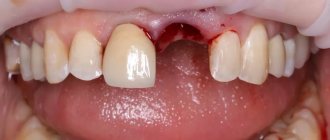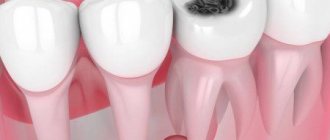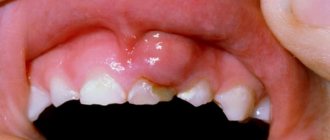- Physiological causes of gum swelling
- Pathological causes
- The gums are swollen and painful
- The gum is swollen and bleeding
- Flux with pus
- When you need to see a doctor urgently
- How to relieve pain
- How to treat swollen gums
- Rinse recipes
Bad teeth are not always the reason for going to the dentist; often patients come with gum pathologies. The reason for treatment is serious tissue damage with inflammation and suppuration. You should not try to treat them yourself - in order to avoid the development of disease due to gum tumors, you should consult a doctor as soon as possible to prescribe adequate therapy.
Causes of gum swelling
Physiological
Normal gums are pink, painless and of normal size. But sometimes they swell for natural reasons:
- during teething - in children and adults (wisdom teeth);
- after tooth extraction—slight swelling and redness of the gums is observed for up to 3 days;
- after injury - damage to the soft tissues of the gums leads to their swelling for some time while integrity is restored;
- during pregnancy - under the influence of hormones and due to the redistribution of blood in the body, gums may swell in women carrying a child;
- injury from dental structures - veneers, braces and fillings, if installed incorrectly, come into contact with gum tissue, causing damage to them.
There is no need to panic if the gums of a child aged 1 to 7 years are swollen. At this time, baby or permanent teeth erupt, which may cause swelling and redness in this area. Sometimes small balls appear - cysts. They are safe and in most cases go away on their own over time. If the cyst interferes with tooth eruption, it is surgically removed in dentistry in 1 session. The procedure is performed under anesthesia and does not cause any discomfort.
Pathological
In most cases, gum swelling occurs due to inflammation. Pathological reasons:
- periodontitis - local inflammation above or below the tooth;
- periodontitis - inflammation of periodontal tissues;
- gingivitis - inflammation of the gums;
- periodontal abscess - suppuration localized at the edge of the tooth;
- stomatitis - ulcers that appear on the soft tissues of the oral cavity;
- secondary infection against the background of immunodeficiency - with HIV or hepatitis, even opportunistic microorganisms can cause oral diseases;
- atypical sore throat - spreads to the gums, the main symptom is that it is painful for a person to swallow;
- Vitamin deficiency C - a lack of vitamin affects the gum tissues, causing them to swell.
Swelling of the gums due to an allergic reaction is also considered pathological. It can develop from an injection of an analgesic during dental treatment or from any irritant to which a person is sensitive.
Swollen gums near the tooth: how to treat?
At the first signs of swelling, you should immediately contact your dentist, even if the cause of the disease seems obvious. After a preliminary examination, the doctor will definitely send the patient for an x-ray to get a more complete picture. After analyzing the resulting image, an accurate diagnosis will be made, based on which it will become clear what to do with the tooth: sometimes it can be cured, sometimes, if the situation is too advanced, the tooth will have to be removed.
Treatment methods depend on the cause of the swelling.
Swollen gums from poorly filled canals
In this case, treatment can be therapeutic or surgical.
- If it is decided that therapeutic treatment will be sufficient, then on the first day of the patient’s visit, the doctor removes the filling from the affected tooth, unfills the canals, which are thoroughly washed with an antiseptic solution, and prescribes a course of antibiotics. Sometimes an incision in the gum may be required, for which the patient is referred to a surgeon. When the inflammatory process decreases, the root canal is filled again, but first an x-ray is taken: filling is possible only if it turns out that the source of inflammation is insignificant in size. If a cyst appears at the top of the root, and the inflammatory focus is large, the root canals are sealed for several months. After this period of time, the patient must make another appointment with the dentist for a permanent gutta-percha filling and a filling placed on the tooth.
- Surgical treatment involves resection of the upper part of the root. Despite surgical intervention, this method is much simpler, faster and cheaper than the one described above, however, it is permissible to resort to it if the root canals are filled poorly only at the very top, but the rest of the length is normal. During resection, the doctor removes the upper part of the root with an unsatisfactorily sealed section of the canal, as well as the cyst. The operation takes no more than 40 minutes: the patient can solve his problem in 1 visit, eliminating the long wait, as in the case of therapeutic treatment. Another advantage of resection is that there is no need to remove a crown or filling.
Swelling due to caries and after tooth extraction
When the cause of the swelling is untreated caries, therapeutic treatment is carried out. The difference from the method described above is that the canals do not need to be unsealed: the doctor can mechanically process and expand them without unnecessary actions.
Sometimes after a tooth is removed (especially a complex one), the gums become swollen: this is a normal situation. In this case, the inflammation subsides within a couple of days. However, there are often situations when, after extraction, the tooth socket becomes inflamed and alveolitis begins. To treat it, the doctor removes a blood clot, food debris and plaque containing the infection from the socket, after which he rinses the cavity with an antiseptic and puts medicine inside, which will need to be changed a couple of times (for this you will have to visit the doctor again). Antibiotics are prescribed if necessary. As a home treatment, we can recommend filling the hole yourself with dental adhesive paste using your finger. But this can be done if there is no blood clot inside.
Inflammation of the gums as a cause of swelling
Swelling of the gums with obvious inflammation indicates the formation of an abscess. Self-medication will not help: you need to contact a dental surgeon to make an incision and open the abscess.
The doctor will also wash out the periodontal pocket that caused the inflammatory process and prescribe antibiotics. A couple of days after the operation, it is necessary to carry out ultrasonic cleaning, which will destroy the source of infection - subgingival deposits.
Swelling of the gums with acute pain
When the gums are not only swollen, but also very painful, this may be a symptom of a serious pathology of the oral cavity. Most often, such complaints are accompanied by periodontitis. This is an inflammation of the soft tissues that support the tooth. Other symptoms of periodontitis include:
- increased body temperature;
- suppuration in the area of swelling;
- lack of temperature sensitivity of the tooth, as well as a reaction to sweets.
If swelling in the gums is accompanied by fever, it may be periodontitis. This is due to the fact that the factors in the development of pathology are most often related to infection.
Causes of periodontitis:
- transition of the inflammatory process from the throat or sinuses to the gums;
- penetration of microbes through the dental canal into the periodontium;
- advanced caries;
- poor-quality dental treatment, due to which irritating substances entered the periodontium;
- trauma to the periodontium or the tooth located next to it.
In rare cases, periodontitis develops as a consequence of an immunological reaction, that is, an allergy.
Preventive measures
It is easier to prevent any disease than to treat it later. The recommendations below may seem banal, but they really work.
So, the following will help reduce the likelihood of gum swelling:
- high-quality regular brushing of teeth using dental floss;
- rinsing the mouth after each meal (both special solutions and plain water with added salt are suitable for this purpose);
- undergoing regular dental check-ups. Diseased teeth should be treated immediately at an early stage. You need to visit a doctor at least once a year, but more often is better;
- be especially careful when eating hard foods - nuts, crackers, carrots, etc. In no case should you open bottle caps with your teeth, bite wires with them, or even just hold nails during repair work - all these actions can lead to injury;
- massage your gums. A soft brush is suitable for this purpose; if you don’t have one, you can simply chew the honey in the honeycomb;
- include foods high in calcium in your diet. These include cottage cheese, legumes, eggs;
- stop smoking.
If the gums are swollen, then there is a risk of intoxication of other organs: preventive measures make it possible to save yourself from numerous problems associated with pain and subsequent treatment.
Remember that at the first signs of swelling you should consult a doctor, since only he can accurately determine the cause of the process and prescribe adequate treatment.
If your gums bleed due to inflammation
Bleeding gums, associated with their swelling, is characteristic of periodontitis and gingivitis. In this case, the tooth does not hurt and does not cause discomfort. The difference between these diseases is that gingivitis occurs primarily. And if this condition is repeated more than once, it is already periodontitis - a pathology with a chronic course. Other symptoms of the disease include:
- bright red gum color with a bluish tint;
- pain at the site of swelling or throughout the jaw;
- swelling of the gums partially covers the tooth.
But the main distinguishing feature of periodontitis is bleeding gums. There are several reasons for this condition:
- diabetes mellitus in the stage of decompensation;
- the presence of systemic inflammatory pathologies;
- ARVI and acute respiratory infections;
- Tartar deposits;
- injuries of soft tissues of the oral cavity, occurring with complications;
- long-term treatment with glucocorticoids;
An x-ray is taken to confirm the diagnosis. It shows a noticeable reduction in the interdental septa, and less often, exposure of the tooth root.
Nutrition: prevention of inflammation
If gingivitis is the cause of pain when pressing on your gums, it is important to review your diet by including healthy foods in your diet. To prevent future diseases, first of all, you need to consume plenty of fresh fruits and vegetables:
- Apples and pears contain a lot of pectin, which helps accelerate tissue regeneration.
- Citrus fruits are a real storehouse of vitamin C, which also helps reduce bleeding and inflammation.
- Black currants, blackberries, and raspberries contain a large amount of minerals and vitamins that increase the body's resistance.
- Carrots, cabbage and zucchini are valuable fiber and vitamins that enhance metabolic processes in the body and accelerate tissue regeneration.
To prevent gum inflammation, professional teeth cleaning is also recommended. The procedure is carried out by a dentist and allows you to eliminate all accumulated deposits and tartar.
So, now you know the most common causes of pain in the gums when pressing. Remember: when your gums or teeth bother you, you should never put off visiting the dentist. The sooner the doctor determines the cause of the problem and begins treatment, the greater your chances of saving your teeth, gums and avoiding possible complications.
Sources:
- The role of anti-inflammatory rinse in the treatment of periodontal diseases (L.Yu. Orekhova, A.A. Leontyev, S.B. Ulitovsky) L.Yu. OREKHOVA, Doctor of Medical Sciences, Prof., Head of Department; A.A. LEONTIEV, dentist; S.B. ULITOVSKY, Doctor of Medical Sciences, Prof. Department of Therapeutic Dentistry of St. Petersburg State Medical University named after. acad. I. P. Pavlova
- Clinical studies of antisensitive toothpaste “Asepta Sensitive” (A.A. Leontyev, O.V. Kalinina, S.B. Ulitovsky) A.A. LEONTIEV, dentist O.V. KALININA, dentist S.B. ULITOVSKY, Doctor of Medical Sciences, Prof. Department of Therapeutic Dentistry, St. Petersburg State Medical University named after. acad. I.P. Pavlova
- The effectiveness of the use of Asept “adhesive balm” and Asept “gel with propolis” in the treatment of chronic generalized periodontitis and gingivitis in the acute stage (Municipal Dental Clinic No. 4, Bryansk, Kaminskaya T. M. Head of the therapeutic department Kaminskaya Tatyana Mikhailovna MUZ City Dental Clinic No. 4, Bryansk
When gums are inflamed and even your cheeks hurt
Sometimes the gums not only swell, but a new growth becomes noticeable on it. It is often pale in color due to the presence of pus inside. This is what a periodontal abscess looks like:
- the surface of the neoplasm is elastic and tense;
- swollen tissue around the abscess;
- the palate and cheek swell;
- sometimes the general body temperature rises, more often local;
- swollen tissues of bright red color;
- fluid movement is felt inside the abscess.
This disease is often called "flux". It has a rather characteristic picture. An abscess develops due to lack of treatment for periodontitis: suppuration appears that cannot come out. “Flux” is accompanied by very severe pain and swelling.
Treatment of an abscess is carried out only surgically and in a hospital setting. Attempts to cure flux at home with lotions or self-opening can result in phlegmon, sepsis and, in rare cases, even death. In the best case scenario, the patient will receive major surgery with pus removed through large incisions in the face instead of a small hole in the gum. Therefore, you should not delay visiting the dentist.
Eruption of wisdom teeth: inflammation and consequences
The figure eight on the lower jaw begins to create problems from the moment of eruption, when the crown rests closely on the adjacent tooth or is tightly covered with a hood. When the hood becomes inflamed, favorable conditions are created under it for the proliferation of pathological microorganisms, and the gums are involved in the process. This manifests itself as pain during chewing or when accidentally biting the mucous membrane. It happens that a wisdom tooth partially erupts, and one or more tubercles rest against the hood, injuring it. In this case, the inflammation of the gums near the wisdom tooth will have to be treated by removing the hood or the tooth itself. If the figure eight is healthy and does not interfere with the adjacent tooth during eruption, then the dentist makes an incision in the hood so that the tooth can erupt calmly.
How to treat inflammation of the hood and gums near the wisdom tooth at home? To do this, you will need to regularly rinse, rinse the mouth with antiseptic solutions and take analgesic and anti-inflammatory drugs for pain relief: Nimesil, Ketanov, Ibuprofen. If the hood is inflamed, you can rinse your mouth with weak solutions of the antiseptic Chlorhexidine, soda and saline solutions.
Reason to see a doctor
If you were able to independently determine the cause of the gum swelling (an erupting tooth is visible, an injury is obvious, a tooth was recently removed, etc.) and it does not require the intervention of a doctor, you do not need to go to the clinic. But if the inflamed gum hurts for more than 3 days and there is no improvement in the condition, you should still consult a doctor.
If you have gum inflammation, you need to urgently go to the hospital in several cases:
- there was an unpleasant odor from the mouth and pus was found;
- not only the gums are swollen, but also the cheek;
- when you tilt your head to the painful side, you feel heaviness;
- there is a high temperature;
- swollen tissues are very different in color from healthy ones (white and yellow tumors indicate suppuration, and bluish and burgundy shades indicate blood stagnation);
- the pain seems to pulsate and is not relieved by analgesics.
Even in the absence of these symptoms, but if the cause of gum swelling is unknown, it is worth visiting a specialist. This will help avoid dangerous complications, as well as quickly alleviate the condition, relieve or reduce pain.
What will the dentist do if the gums become inflamed after installing a crown?
First of all, the doctor will order an X-ray to determine the cause of inflammation of the gums under the crown. Treatment by the dentist will also be selected based on this information.
Most often in these cases it is necessary to remove the crown. Additionally, patients are prescribed anti-inflammatory treatment and antibiotics. It is possible to re-prosthetize a tooth after the gums have become inflamed only when the anti-inflammatory treatment has ended. And only then will a new crown be installed.
It is important to understand that folk remedies will not be effective in this case and will not replace seeing a doctor. If you realize that discomfort continues for more than three days, be sure to consult a doctor. Inflammation is a serious process that affects the body as a whole, so it is important to recognize the cause as early as possible and determine effective treatments for inflammation.
First aid for swollen gums
Under no circumstances should a heating pad be applied to an inflamed gum! This is dangerous due to the rapid spread of infection and the development of complications.
To “live until the morning” when you can go to the doctor, you can take several actions that can alleviate the condition:
- apply cold to the sore side - this will constrict the blood vessels and temporarily relieve the fever;
- take an analgesic - but only while you sleep at night; in the morning you need to come to the doctor without pain relief, so as not to erase the picture of the disease;
- drink an antipyretic - if a high temperature prevents you from falling asleep, you can bring it down, but don’t forget to mention it in the morning at the doctor’s office;
- rinse your mouth with an antiseptic - this will slightly slow down the spread of inflammation;
- use a spray with lidocaine on the painful area - this will temporarily relieve the pain.
All of the above measures can only be used as temporary measures. Only a doctor can prescribe adequate treatment after an in-person examination.
Expert advice
Contacting little-known dental centers does not always lead to successful results. If dental prosthetics was performed by an inexperienced doctor, it is not at all surprising that inflammation occurred and additional gum treatment had to be sought. Don't try to save money on your health. We strongly recommend visiting only trusted dental clinics.
To reduce the likelihood of complications, follow simple rules:
- If you feel unwell or have a weakened immune system, it is not recommended to undergo prosthetics.
- Take good care of your teeth, including your artificial crown. Brush your teeth twice a day for 5 minutes, use additional hygiene products.
- Massage your gums to improve blood circulation and avoid possible consequences.
How to treat swollen gums
Treatment of inflamed gums begins with identifying the cause of the disease. To do this, an X-ray of the jaw and an examination of the oral cavity are performed.
Further tactics depend on the established diagnosis. If surgical intervention is necessary (opening an abscess, removing a cyst), it is performed immediately. The patient is anesthetized in the dentist's chair, and then all necessary manipulations are performed.
After surgical treatment, maintenance drug therapy is prescribed. It allows you to avoid the development of complications. Most often, the patient is prescribed rinsing with an antiseptic solution and taking anti-inflammatory drugs. Antibiotics are sometimes recommended to prevent bacterial complications. They should be taken only as prescribed by a doctor, and exactly the drug that is indicated in the prescription. This is important to achieve a guaranteed positive effect.
Some drugs do not combine with each other. Therefore, uncontrolled use of medications can harm the patient himself. If you choose the wrong antibiotic, the bacteria will not only not die, but will also develop resistance to the drug. Then it will take a long time to select a suitable remedy, which will complicate the patient’s life - it will no longer be possible to quickly get rid of unpleasant symptoms.
Rinse recipes
The patient's attending physician should prescribe rinses. They are not allowed for all diseases. After surgical treatment, rinsing too hard can cause the suture to come apart. An infection or food particles will get into an open wound, which will cause new inflammation and suppuration.
It is impossible to completely cure swollen gums with rinses. But they are advised to be combined with drug treatments to alleviate the condition and enhance the effect of the drugs.
- Decoctions of medicinal herbs: chamomile, calendula, lemon balm, sage, St. John's wort. Some components can cause allergies, so you need to be careful with them. However, they have a mild anti-inflammatory effect and can help relieve swelling and reduce inflammation.
- Propolis tincture - dilute it with warm water and rinse your mouth 2 times a day. The product helps against ENT diseases (sore throat and sinusitis), which often develop into inflammation of the gums.
- Soda and salt - add 1 teaspoon of each powder to a glass of warm water and stir. The product has a wound healing effect and helps stop bleeding gums.
In addition to rinsing, lubricating the area of inflammation with tea tree or fir oil is also effective. They have an anti-inflammatory and wound-healing effect. However, they should not be applied to the site of suppuration. It is also worth considering the risk of plant allergies.
There are many reasons for gum swelling, not all of them are obvious. Only a doctor after diagnosis can figure out what caused the inflammation. Independent attempts to cure the disease often lead to serious complications, so you should not expect that the swelling on the gums will go away on its own. It is better to visit a doctor and make sure there are no risks or get competent and timely treatment.
Care
To avoid problems with structures, you should properly care for them. For teeth with crowns, you can use an irrigator and specialized solutions for it, for example, ASEPTA with extracts of medicinal herbs. This will ensure proper cleaning in hard-to-reach places and will be a good prevention of problems with crowns.
In addition, the specialized ASEPTA ACTIVE paste, made on the basis of natural herbs and special enzymes, will help you maintain a healthy state. It eliminates pathogenic bacteria, relieves gum inflammation and prevents bleeding, providing comprehensive protection to tooth enamel.
Daily use of ASEPTA mouth rinse will also help to avoid inflammation; it combines analgesic, anti-inflammatory and antimicrobial effects. It increases the effectiveness of periodontal treatment and prevents the development of many diseases.
Diagnostics
Any pathology associated with the problematic eruption of one or more wisdom teeth should always be investigated through x-ray diagnostics. To determine the position of the tooth in the jaw (inclination, shape, configuration, structure, how it grows), an orthopantomogram is used.
OPTG is a high-quality panoramic image of all teeth on both jaws. Another diagnostic method that will help you understand why your wisdom tooth hurts is visiography.
Treatment
To get rid of an ulcer on the mucous membrane, it is necessary to find out the cause of its appearance. If it’s all about diseases of the body, you will need the help of more than one specialist. If the cause is diseases of the oral cavity, the dentist will treat the teeth under anesthesia , remove plaque and stones, and in order for the wound to heal faster, prescribe special antiseptic solutions for mouth rinsing, gels or ointments with a healing effect. If the pain is severe, your doctor may prescribe a pain reliever.
During the treatment period and after it, the toothbrush must be replaced! Diet will also play an important role: try not to eat acidic foods and be sure to wash food before eating. Pay special attention to fresh vegetables, herbs and fruits. And to strengthen your immune system, take a complex of vitamins and minerals. A healthy body means a healthy and beautiful smile!










